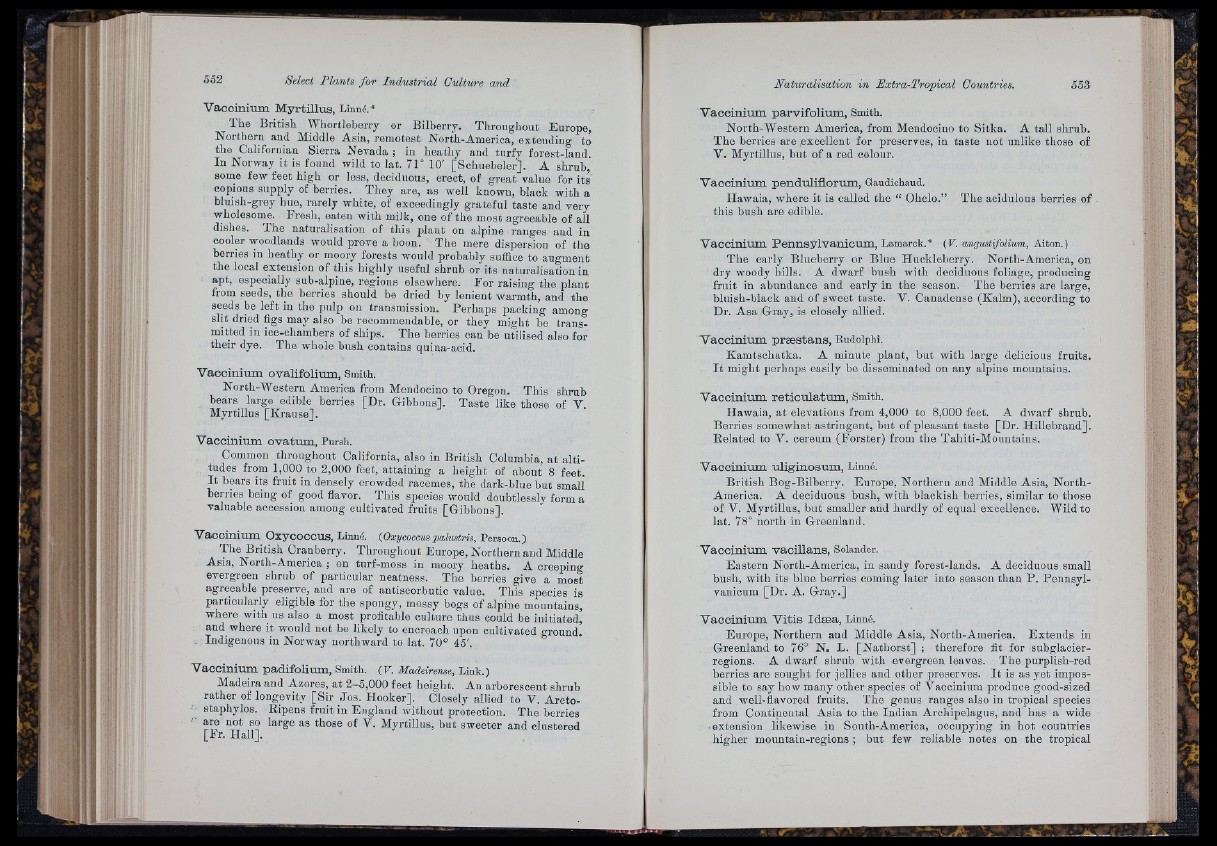
5 ü2
Vaccinium Myrtillus, Linné.*
The British Whortleberiy or Bilberry. Throughout Europe,
Northern aud Middle Asia, remotest North-America, extending to
the Californian Sierra Nevada ; in heathy and turfy forest-land.
In Norway it is found wild to lat. 71° 10' [Schuebeler]. A shrub,
some few feet high or less, deciduous, erect, of great value for its
copious supply of berries. They are, as well known, black with a
bluish-grey hue, rarely white, of exceedingly grateful taste and very
whofesome. Fresh, eaten with milk, one of the most agreeable of all
dishes. The naturalisation of this plant on alpine ranges aud in
cooler woodlands would prove a boon. The mere dispersion of the
berries in heathy or moory forests would probably suffice to augment
the local extension of this highly useful shrub or its naturalisation in
apt, especially sub-alpine, regions elsewhere. For raising the plant
from seeds, the berries should be dried by lenient warmth, and the
seeds be left iu the pulp on transmission. Perhaps packing among
slit dried figs may also be reeommendable, or they might be transmitted
in ice-chambers of ships. The berries can be utilised also for
their dye. The whole bush contains quina-acid.
Vaccinium ovalifolium, Smith.
North-Western America from Mendocino to Oregon. This shrub
bears large edible berries [Dr. Gibbons]. Taste like those of V.
Myrtillus [Krause].
Vaccinium ovatmn, Pursh.
Common throughout California, also in British Columbia, a t altitudes
from 1,000 to 2,000 feet, attaining a height of about 8 feet.
I t bears its fruit in densely crowded racemes, the dark-blue but small
berries being of good flavor. This species would doubtlessly form a
valuable accession among cultivated fruits [Gibbons].
Vaccinium Oxycoccus, Linné. {Oxycoecus palustris, Persoon.)
The British Cranberry. Throughout Europe, Northern and Middle
Asia, North-America ; on turf-moss in moory heaths. A creeping
evergreen shrub of particular neatness. The berries give a most
agreeable preserve, aud are of antiscorbutic value. This species is
partioularly eligible for the spongy, mossy bogs of alpine mountains,
where with us also a most profitable culture thus could be initiated,
and where it would not be likely to encroach upon cultivated ground.
, Indigenous in Norway northward to lat. 70° 45'.
Vaccinium padifolium, Smith. {V. Madeirense, Link.)
Madeira and Azores, at 2—5,000 feet height. An arborescent shrub
rather of longevity [S ir Jos. Hooker], Closely allied to V. Arctostaphylos.
Ripens fruit in England without protection. The berries
are not so large as those of V. Myrtillus, but sweeter and clustered
[Er. Hall].
Vaccinium parvifolium, Smith.
North-Western America, from Mendocino to Sitka. A tall shrub.
The berries are excellent for preserves, in taste not unlike those of
V. Myrtillus, but of a red colour.
Vaccinium penduliflorum, Gaudichaud.
Hawaia, where it is called the “ Ohelo.”
this bush are edible.
The acidulous berries of
Vaccinium Pennsylvanicum, Lamarck.* (V. angustifolium, Aiton.)
The early Blueberry or Blue Huckleberry. North-America, on
dry woody hills. A dwarf bush with deciduous foliage, producing
fruit in abundance and early iu the season. The berries are large,
bluish-black and of sweet taste. V. Canadense (Kalm), aecording to
Dr. Asa Gray, is closely allied.
Vaccinium præstans, Rudolphi.
Kamtschatka. A minute plant, but with large delicious fruits.
I t might perhaps easily be disseminated on any alpine mountains.
Vaccinium reticulatmn, Smith.
Hawaia, a t elevations from 4,000 to 8,000 feet. A dwarf shrub.
Berries somewhat astringent, but of pleasant taste [Dr. Hillebrand].
Related to V. cereiim (Forster) from the Taliiti-Moimtains.
Vaccinium uliginosum, Linné.
British Bog-Bilberry. Europe, Northern and Middle Asia, North-
America. A deciduous bush, with blackish berries, similar to those
of V. Myrtillus, but smaller and hardly of equal excellence. Wild to
lat. 78° north in Greenland.
Vaccinium vaoillans, Solander.
Eastern North-Ameriea, in sandy forest-lands. A deciduous small
hush, with its blue berries coming later into season than P . Pennsyl-
vaniciim [Dr. A. Gray.]
Vaccinium Vitis Idæa, Linné.
Europe, Northern and Middle Asia, North-America. Extends in
Greenland to 76° N. L. [Nathorst] ; therefore fit for subglacier-
regions. A dwarf shrub with evergreen leaves. The purplish-red
berries are sought for jellies and other preserves. I t is as yet impossible
to say how many other species of Vaccinium produce good-sized
aud well-flavored fruits. The genus ranges also in tropical species
from Continental Asia to the Indian Archipelagus, and has a wide
extension likewise iu South-America, occupying in hot countries
higher mountain-regions ; but few reliable notes on the tropical
fr'--,.-